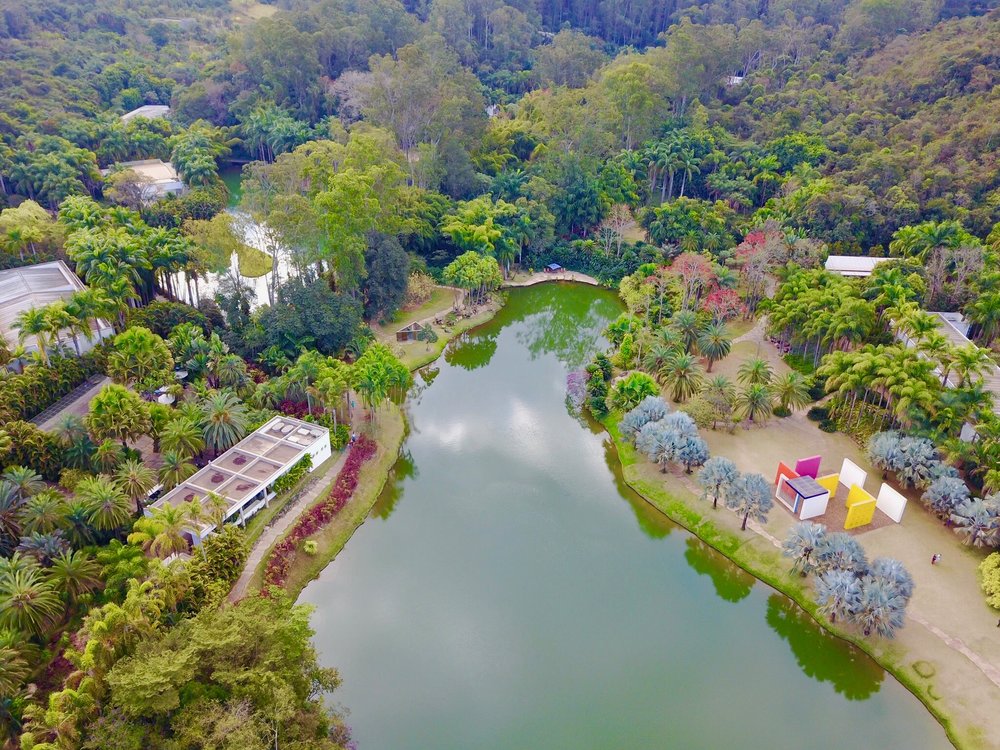BRAZIL April 4-22, 2012
Brazil is about the size of the continental US (fifth largest country in the world – almost half of the SA continent) with a population of 200 million. 55% is white, 6% black, and 38% mixed as 3.5 million black slaves were imported as labour between 1550 and 1888 when slavery was abolished. Every color of brown skin is seen in this very integrated society. It is the world´s largest Catholic country and uses Portuguese not Spanish. It has experienced widespread economic growth and became a net foreign creditor (as opposed to debtor) in 2008 weathering the recent recession better than any other country. It has the world´s 8th biggest economy. Soccer is a national passion. It has impressive colonial architecture in many cities. A narrow 7200 km long coastal band lies between the Atlantic Ocean and the coastal mountain range. The Brazilian Plateau covers most of the country south of the Amazon and has several low mountain ranges. 20% of the Brazilian rainforest has been destroyed. The Amazon basin comprises 42% of the country, even though more than half of the Amazon watershed lies in Peru. The Amazon contains 20% of the world´s freshwater. It has more species of plants, freshwater fish, and mammals than any other country. Sugar cane, then coffee were the mainstays of the economy and a massive underwater oil field was discovered in 2007, which along with the world´s largest production of biofuels, makes it energy independent. There is huge income disparity between rich and poor but its crime rate is no greater than the US: There was significant urban migration in the mid 19th century and the poorest live in favelas or slums that surround every city. Significant immigration from Europe occurred in the mid 19th century. This is by far the most expensive country traveled in so far – seems equivalent to Canadian prices. Brazilians are very appearance conscious – apparently the popular soap operas set styles in hair, clothing and jewelry. The food is also the worst I´ve had in SA – breakfast is a lot of deep-fried pastries, other meals are rice and bean based with meat. Another language (most Brazilians are unilingual Portuguese and know less Spanish than I do – Portuguese is quite different and I don´t understand a thing they say). Plus another currency – $1US= 1.85 Brazilian reals.
After crossing the border to the town of Foz do Iguacu (pop 311,000), I went 20 km south to the Brazilian side of Iguazu Falls. There is a 1.1 km trail on the edge of the cliff that gives panoramic views of all the lower falls on the Argentinian side, some that cannot be seen in Argentina. There is no access to the dramatic Devils Throat.

I unfortunately left my Kindle somewhere. The next day I returned to Puerto Iguazu in Argentina and the bus company had the Kindle!!! It took 4 hours, $4 worth of bus tickets and a whole page in my passport to get it, but I would be lost without it. It has wi-fi and 3G so I can download books anywhere and I get 2 magazine subscriptions. I have recently read 1491, 1493, City of Joy, and Killing Pablo (about Pablo Escobar), all great reads.
I have been delayed 2 extra days getting my Brazilian visa and all the buses to my next destinations were booked yesterday (got absolutely the last seat on the bus to Campo Grande to see the Pantanal).
After a 14 hour overnight bus ride to Campo Grande (pop 724,000), it was nice to be met at the bus depot and transported to the hotel to start a 3 day tour to the southern Pantanal. This is the major ecological attraction in Brazil. It is a lowland in western central Brazil that varies in elevation by only 1-2 meters. During the rainy season it is inundated with water producing patches of dry land where animals cluster producing an enormously rich feeding ground (650 bird species and 80 different mammals). The rainy season is from October to March and the water rises in the Pantanal as much as 3m above dry season levels – in March in northern Pantanal and as late as June in the south which is accessed from Campo Grande. The hot tourist spot is Bonito, a 5 hour bus ride from here but I had already arranged a 3 day tour with Gils Pantanal Discovery.
I was met at the bus depot and driven to the hotel for a nice breakfast and then a hot 4 hour drive into the Pantanal to a lodge on the side of the Miranda River. We went on a truck safari where we saw howler monkeys, capybara (the largest rodent in the world), coatis, caiman alligators, brock deer, fox, raccoon, and many kinds of birds. Normally there would be a metre of water everywhere but now it was completely dry (the guide thought that it has been drier for the last 5 years and he thought it was because of deforestation and subsequent soybean planting). Cattle are the major economy here. That night an incredible lightning storm lit up the eastern sky with flashes at least every second for over an hour. The next day was a horse ride which was very lame as no galloping was allowed. We saw white lipped peccaries, rheas, storks, hyacinths macaws, toucans, and many more birds. That afternoon was a long-boat ride along the river to see many capybaras, caiman, swamp deer, giant river otter, kingfishers and more birds. The next day was piranha fishing where we caught 7 and had them for dinner (very bony). Jaquar are fairly common but not often seen as they are nocturnal. The Pantanal has been very hot and humid and there are lots of mosquitos.
After another long van ride back to Campo Grande, I caught a 14 hour bus to Sao Paulo (pop 20.2 million – 5th largest after Tokyo – 34 million, Mexico City – 22.8, Seoul – 22.3, New York – 21.9, then Bombay – 19.9, New Delhi – 19.1, Shanghai – 18.2, LA – 18, Osaka – 16.8, and Jakarta – 16.5 to round out the top 10) where I did not stop as there was nothing special that I wanted to see. Terrain through Brazil has been quite flat with fields of everything and cattle. In Sao Paulo, I had to take two metros to another bus station (Tiete, the largest bus station in SA) to find that the first bus to my next destination, Paraty, was 8 hours away. I arrived in Paraty on the Atlantic at 3:30 AM and thought it would be dodgy to wait around the bus depot so caught the next bus at 4:30, 2 hours north to Angra dos Reis. It was then a 45 minute catamaran to Ilha Grande, a very popular island with great beaches. It is a major holiday site for all the residents of Rio.
Ilha Grande is Brazil´s 3rd largest island and is 150 km south of Rio. The ferry lands in the only town on the island – Abraao (pop 5000). I climbed the Parrots Beak, at 982m, the highest point on the island. Hot and humid, it took me 4 ½ hours return. The top is a spectacular vertical granite hunk of rock with great views of the east end of the island. On day 2, I took a speedboat tour visiting seven sites on the north inward side to different beaches and snorkelled at several. There were relatively few species of fish but some nice coral. The next morning I walked 3 hours along the NE side of the island to an aqueduct (built in 1893 to carry water to Lazareto – 140m long), the beautiful Feiticeira Waterfall, down to the Feiticeira Beach, the ruins of Lazareto (old cholera quarantine site from the 1890´s and subsequently a jail in the 1940´s), and then back to Abraao. The howler monkeys made an incredible racket for about 15 minutes at the beginning of the hike. I then caught the ferry back to Angra and a bus to Rio de Janeiro where I had a 6 hour wait in the bus depot to catch a 9 hour night bus to Ouro Preto, a beautiful colonial town north of Rio.
Ouro Preto (pop 67,000), originally the site of many gold mines, is one of SA most gorgeous colonial towns. Nestled in a steep walled valley amid nice mountains, it has many stunning Baroque churches, picturesque plazas, winding and often very steep cobbled streets, museums, and nicely painted colonial houses and buildings. It was designated a Unesco World Heritage Site in 1980. Its most famous citizen, Aleijadinho, lost the use of his hands but with a hammer and chisel strapped to his arms, carved amazing sculptures and religious figures in churches many from soapstone.
I took an early bus 2 hours north to Belo Horizonte (pop 2.5 million, the 3rd largest city in Brazil and a concrete jungle) and then a one hour bus to Inhotem, the most amazing museum you have never heard of. The private collection of a Brazilian, it consists of 350 contemporary works in nine nonlinear galleries set in a biological garden that is a museum in itself. The first thing one notices is the palm trees – there are 1300 species, the most anywhere in the world. The flowers, big trees, several lakes, huge rock paver walkways, and mammoth benches and chairs carved from tree trunks are all stunning. There are many restaurants and beautifully designed seating areas. The art is quite out there – there are huge pieces housed in large galleries plus multiple other outdoor pieces all over the place. It took me over 6 hours to walk and I saw pretty well everything – it was quite a special day.

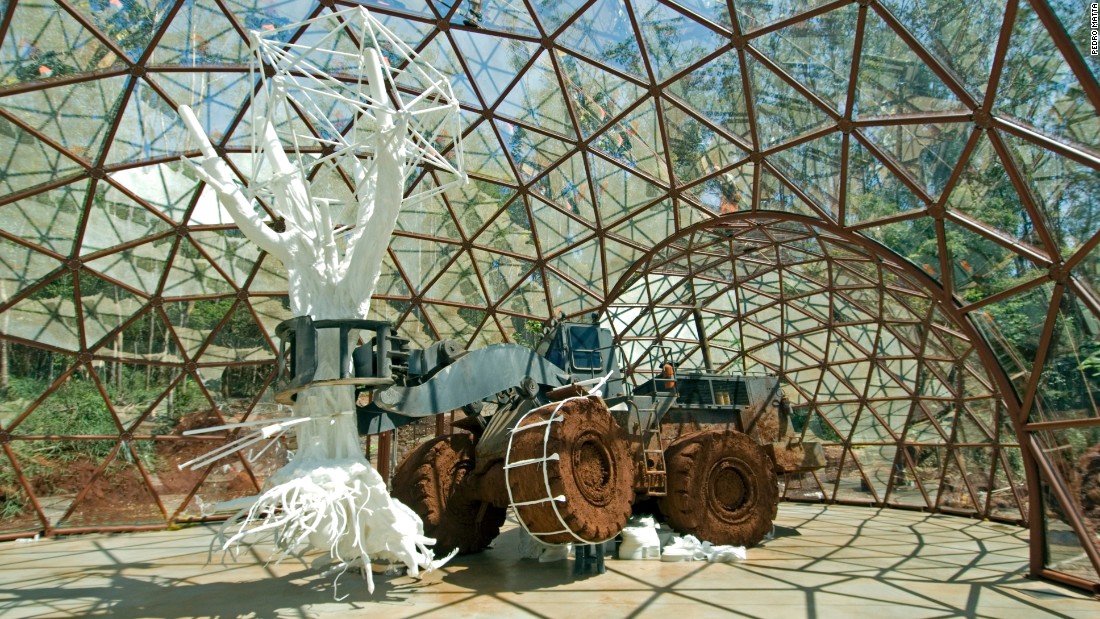
I caught an 8 hour bus the next day back to Rio de Janeiro (pop 6.1 million) to spend a week. Initially the bus traveled through high green hills and then through the coast mountains with many rock faces.
After taking the bus and getting off at the wrong place, I walked for 30 minutes and finally settled into my 10 bed dorm at a hostel in Ipanema. It is a party hostel with many 20 somethings – the music in the bar/lobby was deafening. The next day was raining and I spent the morning dealing with identity fraud – my debit card was copied at an outdoor ATM in Angra dos Reis and about $1800 had been withdrawn from my account over the previous 72 hours. Luckily I checked my bank account after only 3 withdrawals had been made and the daily withdrawal limit of $500 saved me here. Pay phones did not work, a fourth withdrawal was made, and the hostel let me use their phone to cancel the card. I have since realized that a quick easy way to cancel your debit or credit card is to go to any ATM and enter your PIN incorrectly three times. It was investigated by the RBC fraudulent activity section and I got all my money back four days after reporting it.
At noon I left for a big walking day – down Ipanema and Copacabana beaches to Sugar Loaf. Cloudy and humid at 25 degrees, the beaches were almost deserted and there were no hot bodies to gape at. It then took me about an hour to walk to Sugarloaf through a large tunnel and then on the water forming the west side of the harbour (one of the 7 natural wonders of the world) just NE from the end of Copacabana. Sugar Loaf is a sheer 600 million year old spire 396 m high made of quartz and feldspar. A cable car was built to the top in 1912 and updated in 1972. The first car goes to the top of Ucca (Dog face mountain at 220m) and one can walk around for great views. A second car takes you to the top of Sugar Loaf. It is a short walk down to get views across the mouth of the harbour and then back to a large terraces for great views of all the city. With a map you can see all the neighbourhoods, beaches, great bands of rock that divide the city up, and several favelas. Planes landing at the domestic airport to the north turn right in front of SL. To the north of Labron, Ipanema and Copacabana neighbourhoods are huge rock bluffs (with tunnels to provide access) separating them from the rest of the city. It really is in a spectacular setting. Visiting the city is all about the natural wonders. Sugar Loaf a great way to get orientated.
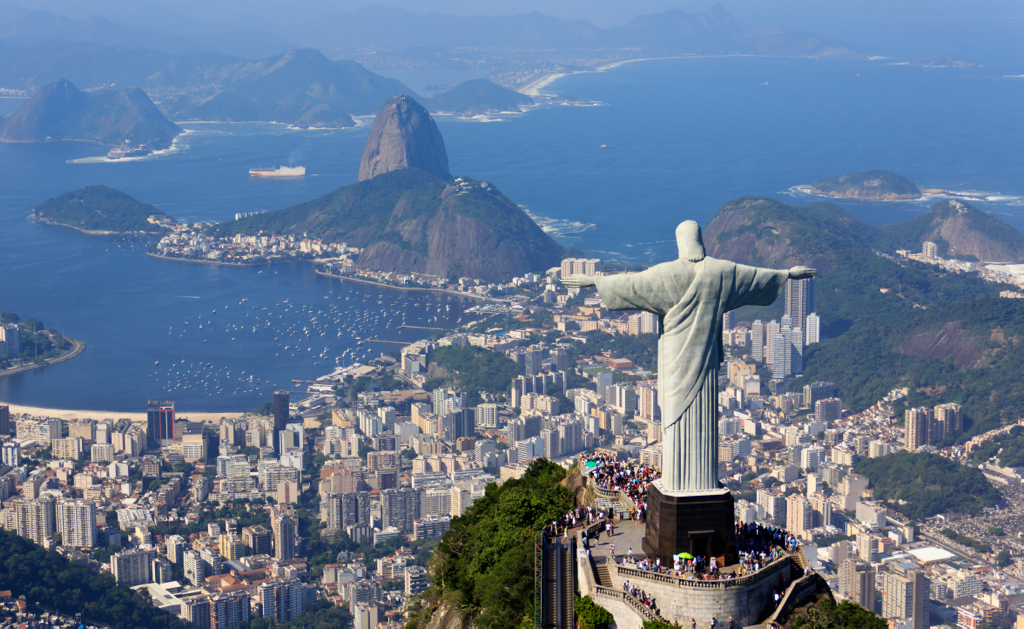
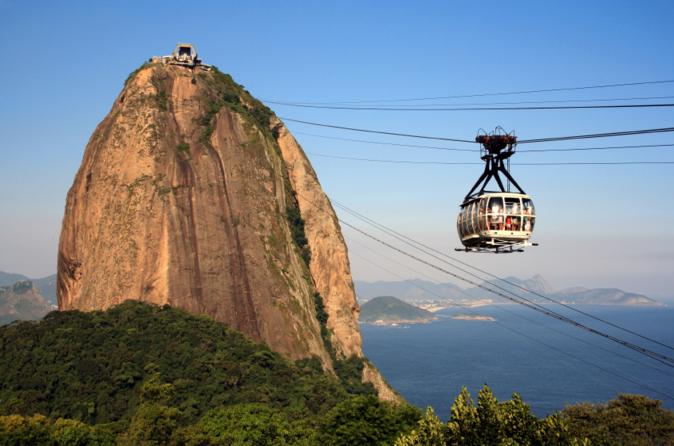
I then walked all the way back through the city, a mecca of restaurants and shopping. Rio is very expensive – hostels are 2-3 times the price of elsewhere and food is considerably more. That night, with 3 American airline pilots, I went on a party boat cruise from midnight to 4 AM. I was totally out of my element as most everyone on the boat was less than 25, the music was loud with a bass heavy beat, the food poor and the drinks expensive. Still had a good time people watching and moving around the boat looking at the city skyline. The boat cruised all over the gigantic Harbor of Rio de Janeiro going out to the huge bridge crossing the harbour to Niteroi, the city on the opposite side. The bridge was finished in 1985, is 13.3 km long, the largest prestressed concrete bridge in the S hemisphere, and the 6th longest bridge in the world.
I took a day off and then went to the Botanical Gardens with lots of great trees, orchids, but few other flowers. I then climbed Corcovado, the mountain with Christ the Redeemer on top. 700 m to the top, the trail was steep and hot and humid through mature second-growth Atlantic rainforest. The area was completely deforested at one time and used to grow coffee until the area was replanted over 10 years starting in 1861. The temperature in Rio has dropped 9 degrees and the city water supply recovered since the replanting. I took 1 ¾ hours to walk up. Christ the Redeemer is now one of the seven wonders of the modern world and is an instantly recognizable icon for Rio and Brazil. Made of reinforced concrete, it is 130 feet tall including the 31 foot base, its outstretched arms are 96 feet wide and it weighs 635 tons. It is the largest Art Deco statue of Christ and the 5th largest of Christ in the world. It can be seen from all over Rio and is lit up at night. The views from the top are spectacular and one can see every neighbourhood so this is even better than Sugar Loaf to get orientated to the city. It was a long hike down the road taking 3 hours to get to the metro station and my ride home. On my 4th day, I took the city bus out to Central, Rio´s busy commercial district. It has many baroque churches, museums, plazas and narrow streets filled with colonial buildings. The modern metropolitan cathedral is the most unusual church I have ever seen. Finished in 1964, it is a concrete cone with a 300 foot high ceiling. There are 4 huge abstract stained glass windows extending the length of the sides. It seats 20,000 people.


After walking through the neighbourhood of Lapa, I took the busy passenger ferry over and back to Niteroi across the harbour from Rio.
On day 5, I took a tour to Buzios (pop 24,000), a beach resort 180 km east of Rio. Originally a small fishing village, it gained fame in 1964 when Brigitte Bardot used it as her hideaway. It’s 26 beaches and many high-end hotels, restaurants and shops now attract international jetsetters. There was a boat trip where we visited 3 beaches near town and swam, then had lunch and wandered around town. I was the only gringo of the 100 or so people on the boat.
On day 6, I went on a favela tour. These are the slums that surround many big cities but especially Rio. They exist on land they don´t own, or pay taxes. Services like sewage, water and electricity are basically jury rigged – 20 one inch water pipes run beside the sidewalk and power lines are an incredible maze of wires a few feet off the ground. It would be impossible to find your line if you had a problem and so another one is simply put up. Garbage was everywhere, as were bullet holes. Building codes are nonexistent and as there is no more land, people buy property on somebody´s roof and things just keep going upwards. Drug gangs and militias control the place although in anticipation of the World Cup (2014) and Olympics (2016), both in Rio, the military and police have moved into several favelas in an attempt to bring law and order. We rode to the top in motorcycle taxis and walked down Street `1`, a narrow walkway made for single file traffic.

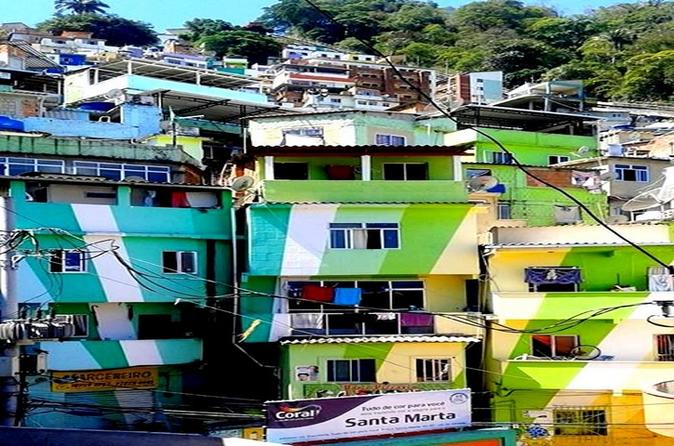
That night I went to another futbol game, between Bangu and Botafelgo, a semifinal game for the championship of the Rio league. It was on a tour so was picked up near my hostel. There were no crowd control gates starting blocks from the stadium, no police, one brief frisk where my water bottle was taken away, wide walkways entering the stadium with no rowdy fans, the beautiful Olympic stadium with a relatively sedate crowd, no band, and a great view of the whole field – ie. kind of boring. Even the futbol was mediocre – nowhere near the experience in Buenos Aires when I went on my own and had to figure everything out. My 7th day was rainy and I basically took the day off to read and get ready for my 5 AM taxi ride to the airport and my last country in South America – Venezuela.
Cost of Brazil (not including airfare to Venezuela): 19days – $2290=$121/day
